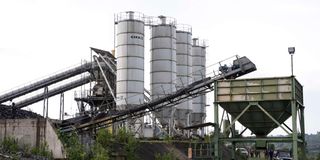Nakuru’s water woes deepen as Itare dam stalls

Some of the machines at the stalled multi-billion Itare Dam project in Kuresoi North, Nakuru County on May 20, 2024. The stalled project has left Nakuru County struggling to meet residents’ water needs, forcing the devolved unit to spend billions drilling boreholes as an alternative water source.
What you need to know:
- A Cabinet dispatch from April 25, 2024, indicated that the government had reached an agreement with CMC de Ravenna to resume work.
- CMC de Ravenna had initially sued for Sh12 billion, seeking compensation, but later withdrew the case.
The stalled Sh38 billion Itare Dam project in Kuresoi has left Nakuru County struggling to meet residents’ water needs, forcing the devolved unit to spend billions drilling boreholes as an alternative water source.
In the past three years, the Nakuru County Government has spent over Sh3 billion drilling 60 boreholes to alleviate the region’s persistent water shortages.
With no signs of the dam's revival, the county now heavily relies on boreholes and water pans.
Last week, the county acquired a Sh70 million water drilling rig to accelerate borehole drilling aiming to construct at least 70 more boreholes within two years.
According to Deputy Governor David Kones, the machine can drill more than 10 boreholes per month, reaching depths of 450 metres.
The county estimates that using the new drilling rig will cut borehole construction costs by 30 percent, making it a more sustainable approach to tackling water scarcity.
To ensure long-term sustainability, the county has solarised 45 boreholes, constructed 23 water kiosks, and installed 43 water tanks with a combined capacity of 1.58 million litres.
Dr Kones further revealed that the county has expanded its water pipeline network by 407 kilometres, reaching more communities and increasing access to clean and safe drinking water to 62.3 percent of the county’s population.
But despite these efforts, Nakuru still suffers a daily water deficit of 75,000 cubic metres and the stalled Itare Dam project was expected to supply 100,000 cubic metres per day.
Nakuru's Water Executive Dr Nelson Maara said that public participation will be key in identifying the most critical water needs across the county’s 55 wards.
“Nakuru is classified as a water-scarce county, with a heavy reliance on underground water. The borehole drilling equipment will help us construct 70 additional boreholes over the next two years, bringing the total to 130,” said Dr Maara.
In the past few months, boreholes have been drilled in Naivasha, Kuresoi South, Kuresoi North, Nakuru West, Njoro, Gilgil, and Rongai. Dry areas such as Rongai, Gilgil, and Kuresoi North have been prioritised to ease water shortages.
“We seek to drill and rehabilitate more boreholes, expand water pipelines, and desilt dams to increase water supply coverage,” Dr Kones added.
The Itare Dam launched in 2016 was billed as the largest water supply project in the South Rift region after the Sh5.5 billion Chemususu Dam in Baringo County.
With a budget of Sh38 billion ($370 million), the dam was expected to serve one million residents across Kuresoi, Molo, Njoro, Rongai, Nakuru City, Kericho, and Baringo counties.
However, construction stalled in 2018 when the Italian firm Muratori & Cementisti (CMC) de Ravenna, which was contracted to build the dam, filed for bankruptcy in an Italian court.
The dam later became embroiled in corruption investigations by the Directorate of Criminal Investigations (DCI), further complicating its revival.
President William Ruto pledged to revive the Itare Dam upon taking office blaming its stalling on political sabotage during the Uhuru Kenyatta administration.
However, two years into his presidency, no significant progress has been made with disappointed residents continuing to demand action.
“Itare Dam was meant to solve Nakuru's water crisis, but we're still waiting for its revival as promised by the President. Meanwhile, we continue suffering as the county government turns to boreholes,” said Joseph Mutai, a resident of Kuresoi North.
Ms Alice Korir, another resident of Kuresoi North, echoed the frustration saying "this project is long overdue. If completed, it would permanently end our water problems. I urge President Ruto to revive it without further delays."
During a visit to Nakuru, Government Spokesperson Isaac Mwaura had assured residents that the project would resume in late 2023. However, this promise has yet to materialise.
A spot check by the Nation.Africa at the dam’s construction site in Ndoinet, Kuresoi revealed that the area remains abandoned with no ongoing works.
The government has been exploring ways to restart the project, but it remains uncertain when or if construction will resume.
A Cabinet dispatch from April 25, 2024, indicated that the government had reached an agreement with CMC de Ravenna to resume work.
CMC de Ravenna had initially sued for Sh12 billion, seeking compensation, but later withdrew the case.
“Consequently, the government and CMC de Ravenna will enter into a court settlement. Under the new terms, the Itare Dam will be completed, while the stalled Arror Dam construction will begin,” the Cabinet brief read.


